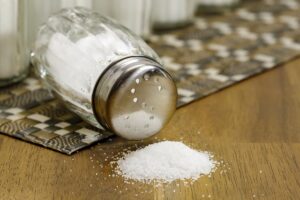Why is U.S. groundwater getting saltier?
- “Miracle Weight-Loss Drug” Sweeps Across America
- The United States Avian Influenza Outbreak Worse Than Expected?
- Global First: Bovine Avian Influenza Transmission to Humans Detected
- Potassium-Enriched Salt Substitutes: Reducing Blood Pressure Risk?
- Tritium Detection in Fukushima’s Seawater: Below Safety Standards
- What Reason Let AstraZeneca Withdraws COVID Vaccine From The Market?
Why is U.S. groundwater getting saltier?
- AstraZeneca Admits for the First Time that its COVID Vaccine Has Blood Clot Side Effects
- Was COVID virus leaked from the Chinese WIV lab?
- HIV Cure Research: New Study Links Viral DNA Levels to Spontaneous Control
- FDA has mandated a top-level black box warning for all marketed CAR-T therapies
- Can people with high blood pressure eat peanuts?
- What is the difference between dopamine and dobutamine?
- How long can the patient live after heart stent surgery?
Why is U.S. groundwater getting saltier? New Study Reveals Increasing Salinity in U.S. Groundwater.
A recent study conducted by the United States Geological Survey (USGS) has raised concerns about the rising salinity of groundwater across the United States, which is attributed to road salt application and irrigation practices.
This increase in salinity poses threats to aquatic life, infrastructure, and human health, particularly due to elements like radium.
For over three decades, scientists at the USGS have been closely monitoring the quality of groundwater in wells throughout the United States.
Their research primarily focuses on detecting potential harmful chemicals or substances that could have adverse effects on ecosystems or human well-being.
In their comprehensive analysis, the staff measured up to 500 different chemical components, including major ions, metals, pesticides, volatile organic compounds, fertilizers, and radioactive isotopes.
Notably, the levels of sodium (Na) and chloride (Cl) ions, as well as total dissolved solids, have seen significant increases, all of which are linked to salinity.
These details and trends from years of research were presented recently at the “GSA Connects 2023” conference of the Geological Society of America.
This study is currently part of the National Water Quality Network, an extension of work that began in 1992 as a component of the National Water-Quality Assessment program.
According to hydrologist Bruce Lindsey of the USGS, “The initial goal was to assess the water quality nationwide, including groundwater, surface water, and ecological health.
Over time, they shifted their focus to certain components that could potentially have long-term adverse effects.”

The U.S. Geological Survey Groundwater Quality Decadal Change Program map shows how concentrations of pesticides, nutrients, metals, and organic contaminants in groundwater across the United States have changed over a ten-year period. Source: U.S. Geological Survey
The USGS Groundwater Quality Decadal Change map illustrates the variations in concentrations of pesticides, nutrients, metals, and organic pollutants in groundwater across the United States over a decade. The map is a valuable resource for understanding how groundwater quality changes over time.
The Impact of Increasing Salinity
Bruce Lindsey explained, “When we look at the 28 components across all 82 networks, the increase in concentrations of total dissolved solids, chloride, and sodium is statistically higher in frequency than other components on our list. If you look at the map, you can immediately see patterns, especially in areas surrounding cities where road salt is heavily applied, particularly in colder weather. We have data on road salt application, and we’ve found a correlation between the increase in chloride, sodium, and dissolved solids and the rate of road salt application.”
However, another region has also witnessed elevated levels of Cl, Na, and dissolved solids, and that is the arid regions of the United States, especially in the Southwest. These areas naturally have high soil salinity, but irrigation practices make the situation more complex.
Lindsey elaborated, “When agriculture irrigation occurs in arid areas, a lot of evaporation takes place. So, if the irrigation water has relatively low salinity, but a significant portion evaporates, the salinity levels can become high.”
Environmental and Health Implications
The increase in Na, Cl, and dissolved solids can lead to various problems, primarily environmental concerns. Many streams rely on groundwater as their source, and higher chloride concentrations can disrupt the natural balance of aquatic ecosystems. Lindsey stated, “The rise in concentrations may take 20, 30, or even 40 years to form…meaning that if the management of salinity sources changes, it may also take that long to recover.”
Dissolved salt ions can also pose issues for infrastructure. As groundwater salinity increases, corrosion becomes a problem. Corrosive groundwater, if left untreated, can dissolve lead and other metals in pipelines and other components of household plumbing.
Lastly, Lindsey and his colleagues have discovered a unique issue related to the increase in salinity that affects human health. In a confined aquifer in southern New Jersey, they found that mixing low-pH water with high-salinity groundwater results in elevated salt levels.
Why is U.S. groundwater getting saltier?
(source:internet, reference only)
Disclaimer of medicaltrend.org
Important Note: The information provided is for informational purposes only and should not be considered as medical advice.



